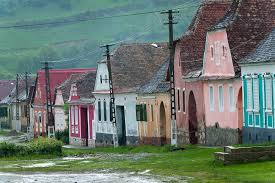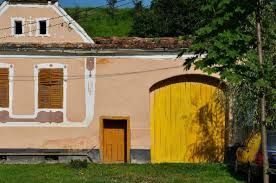I decided to say goodbye to Transylvania today and head west towards Hungary.I had been told that the main road was a dangerous one, and thought that Sunday might be quieter for travelling on it.There is motorway for the first 60km from Sibiu to Deva,so new some of it doesn’t feature on my satnav.The next 100km,till my stop at the village of Minis,just short of Arad ,was single carriageway road in a good state but quite winding so had lots of sectors with no overtaking. Because it’s a busy route for international traffic heading towards Hungary,there are lorries which acquire a queue behind them.The cars, or even other lorries, seem frequently to try to overtake out of impatience ,often on the restricted sections. Despite this I think I was probably correct that Sunday was a quieter day than usual,which was fortunate.
After about 60km from Sibiu I seemed to leave the last of the ordered identikit old Saxon villages behind.They are very attractive,as each house is painted in a different bright colour.There is a standard format to a street.All the houses are detached,gable end to the street.They are single story with a little attic in the eves. Each house then has a wall connecting it to the next house, through which there is a big arched gate,for carriages or carts, into a yard.The walls are painted the same colour as the house,making a continuous line of house,wall with gate ,house,wall ,gate,the street multi-coloured.
After about 60km from Sibiu I seemed to leave the last of the ordered identikit old Saxon villages behind.They are very attractive,as each house is painted in a different bright colour.There is a standard format to a street.All the houses are detached,gable end to the street.They are single story with a little attic in the eves. Each house then has a wall connecting it to the next house, through which there is a big arched gate,for carriages or carts, into a yard.The walls are painted the same colour as the house,making a continuous line of house,wall with gate ,house,wall ,gate,the street multi-coloured.
Leaving this area ,the architecture in villages became much more variable, and the colours much more muted,usually a dirty cream ,or unpainted grey. Despite the disappointment of leaving Transylvania,which had been a wonderful experience,I realised that I was now driving along the road (Highway 7) through the small towns along the banks of the river Mureș where Leigh Fermor had had such a memorable time staying in a series of country houses,featured in chapters 5 and 6 of Between the Woods and the Waters ,and from where he had set off on his motor journey with his girlfriend ,circuiting Sighisoara , Sibiu and the Saxon villages, as I had just done myself.It was the village of Guraszáda, where the von Klobusickys ,the family of Leigh Fermor's friend "Istvan" ,had their estate, and then the next village , Zam where "Angela" had hers .
I stopped at a campsite in the village of Minis ("Camping Route Roemenie" , http://www.routeroemenie.nl/ )on the edge of the very last hill before the great Hungarian plain,about 20km before the city of Arad, and 50km before the Hungarian border.It was another family-run affair,with their little orchard converted.They did evening meals,and I joined 3 Germans at the table for supper,a couple and a single traveller,who all spoke good English.The couple visited occasionally as they were involved in distribution of charity materials to good causes.
Regarding my having read in my guidebook before entering Romania that the country was very behind on delivery of EU infrastructure projects, the couple said that they were last here 2 years ago and had noticed a big stride forwards in the roads since then. It seems on discussing this with the owner of the campsite that every village in Romania does have electricity now but the current contention is the water and sewage supply. Most people in country towns have privies or septic tanks,and the government is trying to force people to pay to be connected to the new sewers they are building to meet EU targets for all villages to have sewerage by 2017.This is not a popular move,as rural people are very poor. According to the charity couple, there are quite a few children who don’t go to school as they have no appropriate clothes or shoes or transport to go,etc(although by and large I think Romania has a high proportion of university graduates too.)Discussing the Roma,it appears that they are not necessarily the poor people in Romania,it is the rural Romanians who are the poor. The Roma were thought by the Germans I spoke with to often do extremely well out of organised begging and other shady dealings in Western Europe and they thought also that they typically drive UK registered cars.I think they were expecting me to explain why, but I hadn’t heard of this !
In fact I did pass a number of the fabled Roma palaces, huge great neoclassical buildings on several levels with colonnades, towers, shiny silver-coloured sheet-metal roofs, in various stages of construction. I was lucky I had not photographed any because apparently if you are spotted you are pursued and often assaulted: the Germans seemed to think you might even be shot at!
I would thoroughly recommend Transylvania as worth visiting.The scenery is beautiful and at times spectacular:there is much to do and see and I felt I hadn't done it full justice in 3 days.As a added bonus all the young people speak good English(in fact excellent English judging by the hoardings advertising the latest museum exhibition in Sibiu,using the slogan 'Go for Baroque')April is definitely the time to visit too.The winters are severe and the summers very hot: In September when it starts getting cooler again, apparently the landscape is brown following the hot summer. Now in April it is beautiful and green, and pleasantly warm.
I didn't have any bad experiences ,and was only bothered by the odd begging child.The main visible issue apart from poverty is Romania's stray dog problem.This is partly the legacy of Ceaucescu's North Korean-esque social experiment whereby he forcibly moved country people into cities to try to create industrial workers.There was no room for dogs,and many thousands were released.There are sometimes packs of them:mostly they ignore you.There are many dead dogs on the roadside.No one knows what to do with them.They have tried killing them,to public outcry.Animal welfare NGOs have been neutering them and releasing them, but recently there was a scandal in Bucharest when a pack of dogs released by a charity killed and ate a small child.So at the moment they are pretty much left alone.
I stopped at a campsite in the village of Minis ("Camping Route Roemenie" , http://www.routeroemenie.nl/ )on the edge of the very last hill before the great Hungarian plain,about 20km before the city of Arad, and 50km before the Hungarian border.It was another family-run affair,with their little orchard converted.They did evening meals,and I joined 3 Germans at the table for supper,a couple and a single traveller,who all spoke good English.The couple visited occasionally as they were involved in distribution of charity materials to good causes.
Regarding my having read in my guidebook before entering Romania that the country was very behind on delivery of EU infrastructure projects, the couple said that they were last here 2 years ago and had noticed a big stride forwards in the roads since then. It seems on discussing this with the owner of the campsite that every village in Romania does have electricity now but the current contention is the water and sewage supply. Most people in country towns have privies or septic tanks,and the government is trying to force people to pay to be connected to the new sewers they are building to meet EU targets for all villages to have sewerage by 2017.This is not a popular move,as rural people are very poor. According to the charity couple, there are quite a few children who don’t go to school as they have no appropriate clothes or shoes or transport to go,etc(although by and large I think Romania has a high proportion of university graduates too.)Discussing the Roma,it appears that they are not necessarily the poor people in Romania,it is the rural Romanians who are the poor. The Roma were thought by the Germans I spoke with to often do extremely well out of organised begging and other shady dealings in Western Europe and they thought also that they typically drive UK registered cars.I think they were expecting me to explain why, but I hadn’t heard of this !
In fact I did pass a number of the fabled Roma palaces, huge great neoclassical buildings on several levels with colonnades, towers, shiny silver-coloured sheet-metal roofs, in various stages of construction. I was lucky I had not photographed any because apparently if you are spotted you are pursued and often assaulted: the Germans seemed to think you might even be shot at!
I would thoroughly recommend Transylvania as worth visiting.The scenery is beautiful and at times spectacular:there is much to do and see and I felt I hadn't done it full justice in 3 days.As a added bonus all the young people speak good English(in fact excellent English judging by the hoardings advertising the latest museum exhibition in Sibiu,using the slogan 'Go for Baroque')April is definitely the time to visit too.The winters are severe and the summers very hot: In September when it starts getting cooler again, apparently the landscape is brown following the hot summer. Now in April it is beautiful and green, and pleasantly warm.
I didn't have any bad experiences ,and was only bothered by the odd begging child.The main visible issue apart from poverty is Romania's stray dog problem.This is partly the legacy of Ceaucescu's North Korean-esque social experiment whereby he forcibly moved country people into cities to try to create industrial workers.There was no room for dogs,and many thousands were released.There are sometimes packs of them:mostly they ignore you.There are many dead dogs on the roadside.No one knows what to do with them.They have tried killing them,to public outcry.Animal welfare NGOs have been neutering them and releasing them, but recently there was a scandal in Bucharest when a pack of dogs released by a charity killed and ate a small child.So at the moment they are pretty much left alone.


 RSS Feed
RSS Feed